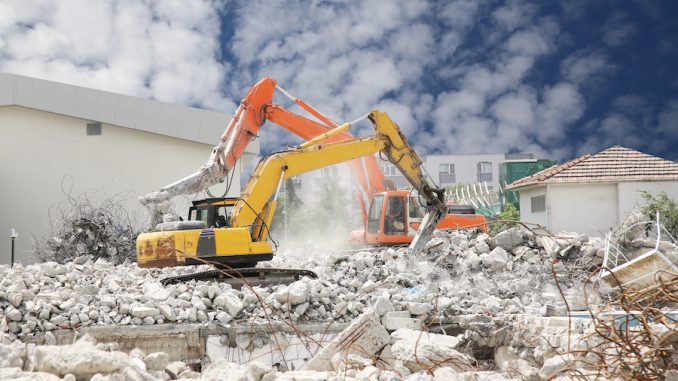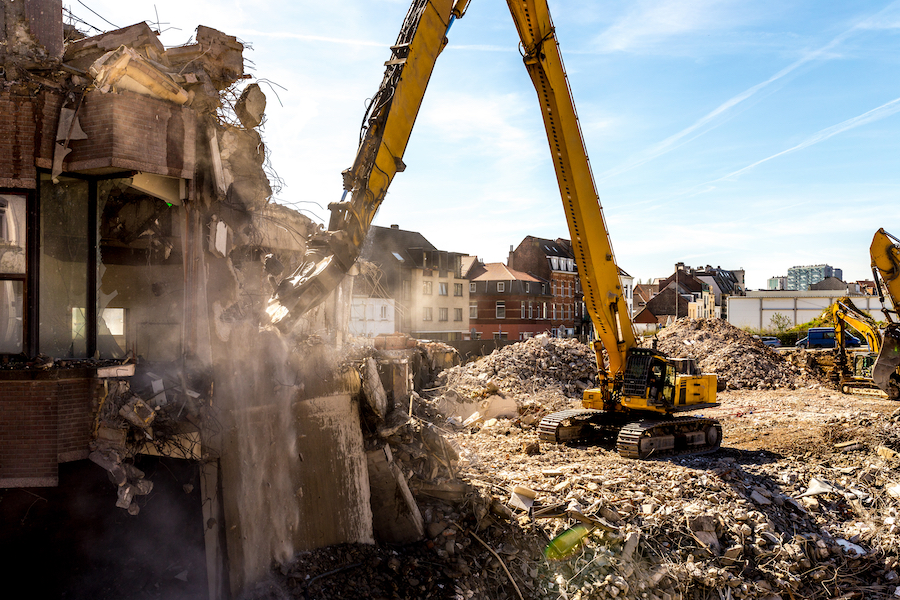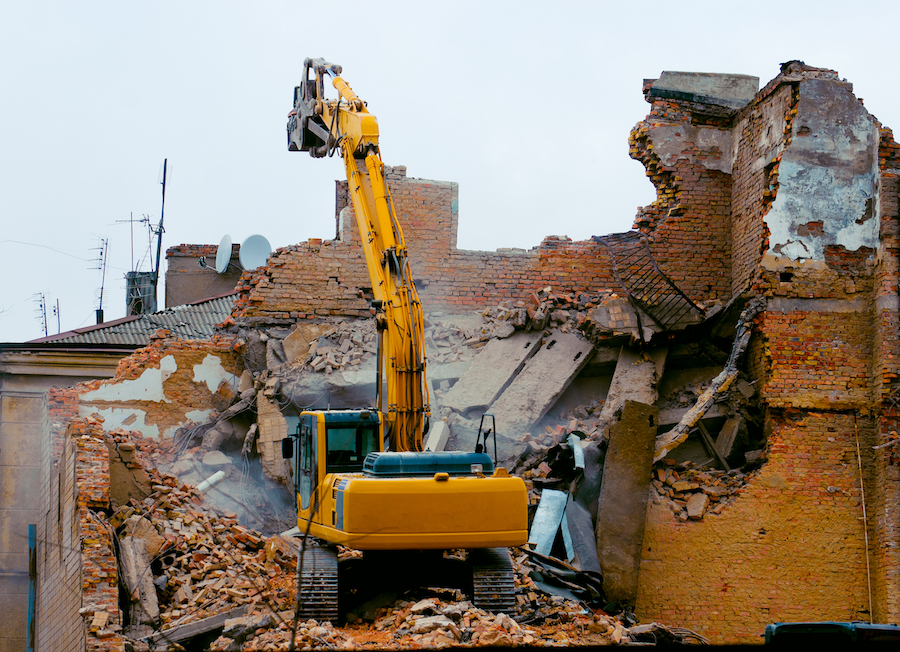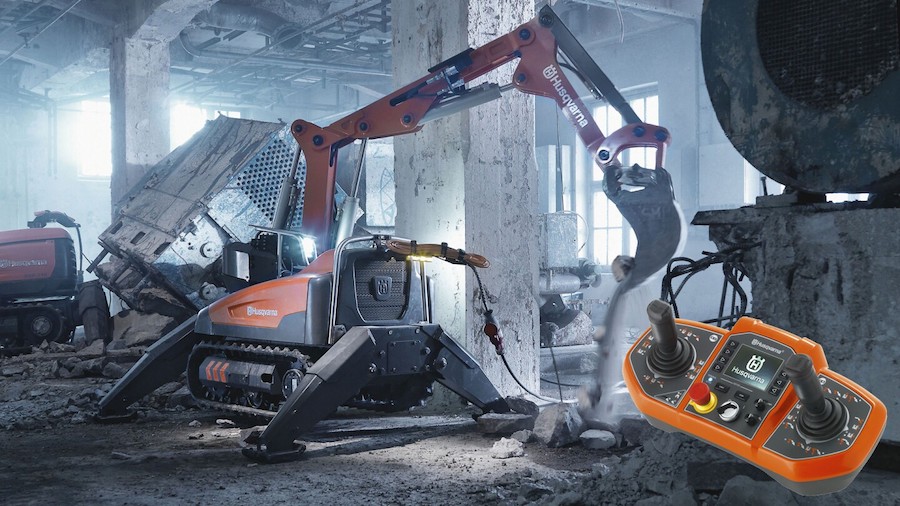
View the complete article here
Watching a multi-story building in the middle of a city get demolished is quite dramatic. Many people enjoy watching all that concrete and steel tumble to the ground. But few know how it’s actually accomplished – other than the fact that explosives are involved in some way. In our Complete Guide to Demolition we explain the different ways to knock down a structure.
Why are Buildings Demolished?
There are several reasons why a building is demolished. Structures may be dismantled because they have weak foundations, or they were constructed with hazardous materials. Sometimes the land is more valuable than the structure. Or a new structure is more useful to the surrounding community. Owners of very old buildings may determine that it’s cheaper to knock it down than repair it.
Types of Demolition
There are several ways to bring down a structure including implosion, high reach arm, wrecking ball, and selective demolition.
Implosion
With implosion demolition, explosives are used to force the building to collapse down on itself from the inside out. This type of demolition is typically done in densely populated urban areas. Detailed structural blueprints are used to help the blaster crew identify where the main components of the structure are located.
High Reach Arm
This type of demolition requires a machine, such as an excavator, with an attached demolition arm or telescopic boom that is long enough to reach the top of taller structures. Various attachments may be used to break up the building. This could be a hammer, shears, or a crusher. The building is broken up from the top down. The machine is used to remove the largest pieces of the building. The demolition ground crew then breaks them up further. Finally, the crew sorts through the debris for disposal.

Wrecking Ball
The term “wrecking ball” – as in such-and-such building escaped the wrecking ball – is used more than the actual wrecking ball method of demolition. It was very popular through the 1930s to 1960s. The ball – which can weigh upwards of nearly seven tons – is typically suspended from a crane by a cable. The operator either drops the ball on top of the structure or takes a swing at it. The building is crushed under the ball’s heavy weight. Unfortunately, wrecking balls cause a lot of dust. This is not the first choice when demolishing buildings that contain asbestos. It’s use is limited by the size of the crane. It requires swinging room that is not often available near power lines and other structures.
Selective Demolition
Selective demolition, or strip-out, is a labor-intensive method. The goal is to reuse or recycle as much material as possible. This makes sense when there is enough valuable material to save. An historical building is a good candidate for selective demolition. Or when a building needs an intensive overhaul, but not a complete demolition. Selective demolition is a good alternative for expansion work. Stairwells and archways, for example, can be selectively removed in preparation for an additional wing of a commercial building.
Preparing for Demolition
In order to properly plan for a demolition, details about the building must be gathered. Two kinds of surveying take place: building and structural.
Building Surveying for Demolition
The purpose of building surveying is to determine:
- How the building was used in the past. And, how it is currently being used.
- What types of materials were used to construct the building.
- The source of any toxicity, such as hazardous materials, chemicals, wastewater, etc.
- Current drainage conditions.
- Shared facilities like common staircases or walls.
- Details about the surrounding neighborhood such as pedestrian and traffic patterns.
- The neighborhood’s tolerance for inconveniences related to traffic disruption, vibration, noise, and dust.

Structural Surveying
The purpose of structural surveying is to:
- Determine how the building was constructed.
- Map out the entire structural system (such as basements, underground tanks, etc.) and evaluate their condition.
- Identify key structural supports.
- Identify load bearing walls.
- Evaluate the overall condition of the building.
Demolition Permits
There’s more to getting a demolition permit than just heading down to the city building department and filling out an application. You will likely need to provide a detailed demolition plan. Other documentation may include an asbestos survey and, if required, certification for asbestos removal. You may need to provide documentation regarding the removal of exterior painted surfaces and dust suppression measures. In some cases you may need to agree that the demolition will be suspended if winds are blowing above a certain speed. Plans for how debris will be contained during demolition may also be required. Ultimately, you need to understand all the requirements for the demolition well in advance.
Implosion Demolition Process
There are generally five phases to the implosion demolition process: Safety preparation, dismantling, explosive installation, detonation, and cleanup.
Safety Preparation
Preparing for a safe implosion demolition generally involves methods for cordoning off the site, controlling rubble and debris, setting up internal communications, implementing worker safety protocols, and installing a security team (such as hiring a security company and coordinating with local police) to protect the surrounding neighborhood.
Dismantling
Sections of the building may be dismantled in advance of the implosion demolition. For example, to separate adjacent structures from the target building. It may make sense to remove parts of the building such as balconies to improve the performance of the implosion. Non-load bearing walls are typically removed. Preparatory dismantling may be required to create distance between the building and the road. Or to reduce vibrations from the explosion.
Explosive Installation
What type of explosives to use and where to place them is very carefully planned. Dynamite is typically used for concrete supports and columns. Cyclotrimethylenetrinitramine, which is commonly known as RDX, is used to collapse steel columns. There are techniques used to control the collapse of the building. For example, installing pre-stressed steel cables into the walls. There are different types of explosives that are used and options for detonators. The explosives are placed in structural columns throughout the building.
Detonation
The timing of the detonation is critical. The explosives installed are detonated less than a second apart. The goal in most implosive demolitions is for the highest point of the rubble to occur at the core of the collapse. A blasting cap is used to ignite the primary charge explosives. It is detonated from a safe distance using an electrical detonator connected to a lead line.
Cleanup
Now the demolition debris is removed. This is typically done with excavators and skid steer loaders that place the debris onto trucks. Material that can be reused or recycled are separated out either onsite or carted off to a recycling facility. Some recycling, such as concrete crushing, may be handled at the demolition site. Ultimately this is an opportunity to generate income and reduce waste disposal. Part of the cleanup plan may require a final clearance report prepared by an industrial hygienist.
Famous Demolition Projects
Any demolition job is risky. But there’s no doubt that a tall building in the middle of a city is particularly risky. It takes a lot of skill, coordination, and know-how to pull off an implosion demolition. Here are two examples.
Champlain Towers South
In the case of the Champlain Towers South in Surfside, Florida, part of the building had already collapsed, killing nearly 100 people. In order for rescue workers to safely continue their search, it was determined that the whole building needed to be demolished.
Landmark Tower
The 30-story Landmark Tower in Fort Worth, TX was built in 1957. It stood empty for 16 years and the decision was made to demolish via the implosion method. A perfect implosion demolition brought the tower down in 2006.
Future of Demolition
Smart demolition is making it safer to dismantle old structures. 3D modeling lets the demolition team test their plan before putting it into action. Robotics are handling the more dangerous aspects of demolition. They’re also improving the accuracy and speed at which demolished materials are recycled.
Robotic Demolition
Husqvarna has a line of remote demolition robots. The DXR 140 can reach up 3.7 meters and reach forward 3.7 meters. It’s compact enough to step through a standard-sized doorway.
The Brokk 170 uses the SmartPower™ electrical system that can demolish concrete at near-silent levels. Attachments include breakers, crushers, and shears.

Demolition Jobs
Many of the same skills that are in the construction industry are needed in demolition. You’re just tearing a structure down instead of building it up. The more specialized demolition jobs – where you are placing and detonating explosives – are typically on-the-job training or apprentice opportunities. Many demolition jobs require only a high school diploma or equivalency. Even though robotics is gaining popularity in demolition, a human must operate the controls.
Conclusion
Demolition has expanded well beyond the wrecking ball. In part because of an environmental focus that favors reuse and recycling. In part because of the rise of the robotic demolition. There are still plenty of jobs for humans in demolition. Many opportunities exist in the demolition field where only a high school diploma is required. Put safety first and the rewards will outweigh the risks.
View the complete article here
Why are buildings demolished?
Buildings are demolished for various reasons, such as weak foundations, hazardous materials, land value considerations, community needs, or when constructing a more useful structure.
What are the key phases of the implosion demolition process?
The implosion demolition process involves safety preparation, dismantling, explosive installation, detonation, and cleanup, with careful planning and consideration for safety measures and environmental impact.









































